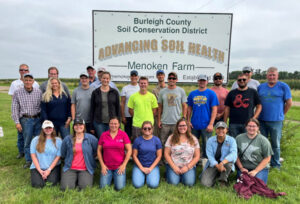Soil Health Trip!
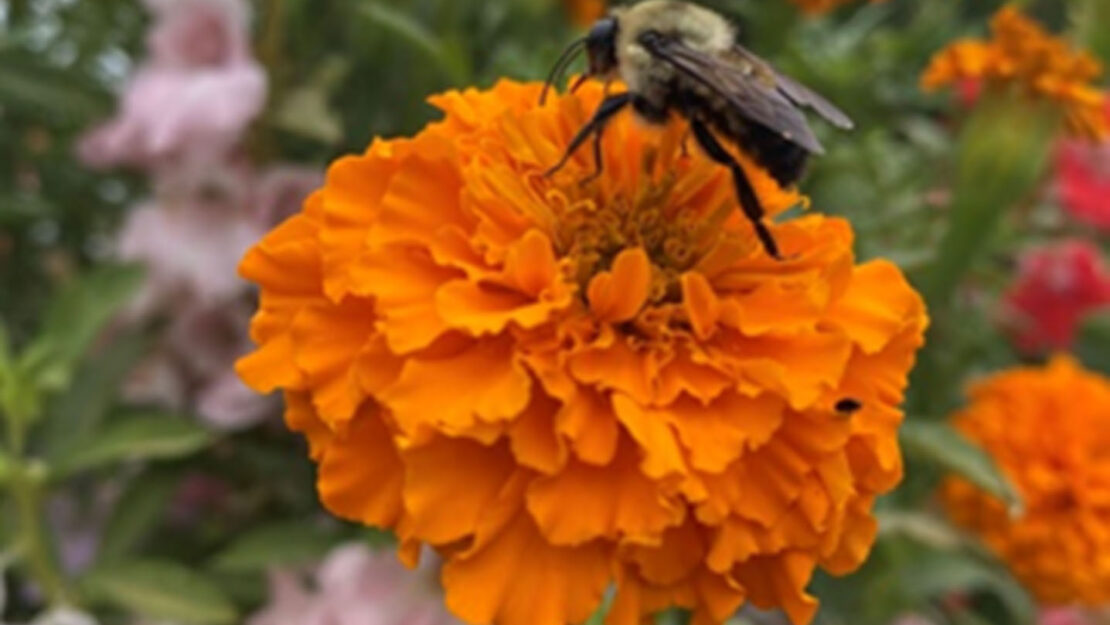
By Anna Fairbanks, Agriculture and Water Outreach Specialist Individual Placement / AmeriCorps member placed with Cottonwood SWCD
Recently, I had the opportunity to go on my first work training trip! For this month’s blog, I am excited to share all that I have learned from my trip to the Menoken Farm. The Menoken Farm is a conservation demonstration farm located in Menoken, North Dakota. The farm is owned and operated by the Burleigh County Soil Conservation District and is used to educate farmers, conservation technicians, and landowners on soil regenerative practices. The land Menoken Farm is now on was conventionally farmed for a century before becoming a demonstration farm. Today, the Menoken Farm addresses resource concerns across the landscape by utilizing the five principles of soil health. Menoken Farm Lead Educator, Jay Fuhrer, was the mentor for our technician training. With Fuhrer, we dove deeply into the fundamentals of improving soil health and took the time to understand “the why” behind soil management. As Fuhrer said, “Farming is interconnected, we are learning the art and science of farming”. Fuhrer gave the group a tour of the farm and prompted us to keep in mind the soil health principles taking place throughout the operation. Now, I want to talk about the building blocks of soil health and then discuss all the interesting demonstrations I got to see at the Menoken Farm! Here’s a recap of my soil health training trip!

Let’s discuss the building blocks of soil health, also known as the five principles of soil health. The five principles of soil health are soil cover, minimal soil disturbance, plant diversity, living roots, and livestock integration. Each soil health principle has several benefits for improving soil and works best when in combination with each other. Managing soil for soil health allows farmers to work with the land and not against it. Here are the five soil health principles:
Soil Cover
Soil cover refers to plant residue and/or living plants on a field’s surface. Soil cover is important as it armors the soil below. The key benefit of soil cover is keeping the soil on the field. The energy from rainfall or wind is absorbed by the cover and thereby reduces soil erosion. Some other benefits of soil cover are less compaction, weed suppression, maintaining moderate soil temperature, increased moisture retention, and habitat for soil biology.
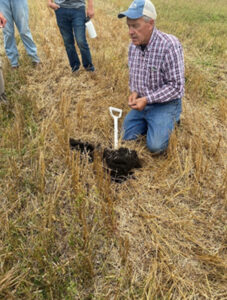
Minimal Soil Disturbance
Minimal soil disturbance means limiting physical, chemical, and biological disturbance to a field. Limiting physical disturbance through reduced tillage or no-tillage leads to more aggregate structure, pore spaces, and organic matter. The absence of compaction allows the roots to penetrate the soil better along with increased nutrient cycling and water infiltration. Limiting chemical disturbance means reducing nutrient, pesticide, and herbicide inputs. These inputs can disrupt the way the soil food web functions. Lastly, limiting biological disturbance means not overgrazing with livestock. Overgrazing can limit the ability of plants to harvest carbon dioxide and sunlight.
Plant Diversity
Having a variety of species within a crop rotation imitates a natural plant community, such as the prairie. The prairie consists of diverse plant types such as grasses, sedges, legumes, forbs, wildflowers, and more. Crop rotations can mimic nature by including cool season grasses, warm season grasses, cool season broadleaf, and warm season broadleaf crops. Diverse plant mixtures ensure soil biology is being fed a diverse diet. With monoculture, soil biology is only being fed one kind of carbon exudate. A diverse crop rotation will prevent soil exhaustion and control weeds, pests, and diseases.
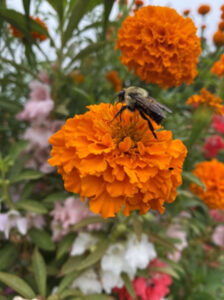
Living Roots
Living roots and soil have a symbiotic relationship. Living roots provide structure and carbon exudates for the soil and the soil provides water and nutrients for the plant to uptake. There are often dormant periods before planting and/or after harvest. Cover crops can fill those periods with continuous living roots. Cover crops can be incorporated into a cropping system as annuals, biennials, or perennials. Cover crops have many benefits such as providing carbon exudates to the soil food web, adding crop diversity, adjusting the carbon/nitrogen ratio, and more.
Integrating Livestock
Integrated crop and livestock systems are a form of management where land is rotated through time between crop, pasture, and livestock use. Rotational grazing allows for the plants to recover between livestock exposure and help to cycle nutrients through vegetation growth. Integrating livestock has many benefits for the soil including balancing the carbon/nitrogen ratio, better manure distribution, reduced added nutrients, and less compaction. Integrating livestock also ensures the livestock get a highly nutritious diet!

Now that we’ve covered the soil health principles, we can talk about what’s being done for soil health at the Menoken Farm! During the farm tour, I got to see the farm’s rain garden, arboretum, bioreactors, high tunnel garden, outdoor garden, beetle bank, multi-species grazing system, and cropping system. Here’s a little about each conservation demonstration and my thoughts while touring the farm:
Rain Garden
The first demonstration we saw during the Menoken Farm tour was their rain garden. A rain garden is a garden that collects rainwater from impervious surfaces such as roofs, driveways, or parking lots. The rainwater collects into a shallow depression that’s landscaped with vegetation. The Menoken Farm rain garden collected rainwater from a barn and hosted native grasses and wildflowers. The plant species were chosen by Menoken Farm because they were native to the area and established quickly. The plants at the top of the depression were hydrophobic and the plants at the bottom were hydrophilic. Rain gardens not only prevent stormwater runoff but are also great for pollinators and add beauty to the landscape. The Menoken Farm rain garden was the biggest rain garden I’ve ever seen! I want a rain garden in the future and visiting this one gave me plenty of inspiration!
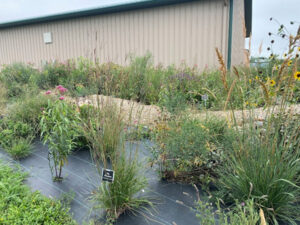
Arboretum
After the rain garden, we got to check out the Menoken Farm arboretum. The arboretum consisted of several windbreaks that showed the variety of species that grow well in the area. Windbreaks are linear tree/shrub plantings designed to slow wind and increase beneficial conditions for people, livestock, wildlife, and crops. I think the arboretum is great marketing for the Burleigh County Soil Conservation District tree program. Tree customers can come to see all the tree varieties sold and get an idea about which ones they want planted on their property. My favorite part of touring the arboretum was the fruiting trees because you could pick a little snack!
Bioreactors
The next stop on the tour was the bioreactors! A bioreactor is a vessel in which raw materials are converted to product by the action of living organisms. In this case, the two bioreactors were compost
piles made of manure, alfalfa straw, rye straw, biochar, and watermelon rinds. The worms within the bioreactor digest the completed compost and then produce worm juice, also known as leachate. The bioreactor is on a 2% slope allowing the leachate to flow into containers and be used on plant crop seeds as a bioinoculant before germination. The seeds can then germinate in a high microbial environment. With this bioreactor system in place, Menoken Farm does not need to use commercial fertilizers, fungicides, or pesticides. I thought the bioreactor system was so cool! We got to peel back the watermelon rinds and straw to see a ton of worms at work. It was amazing to see waste not being wasted!
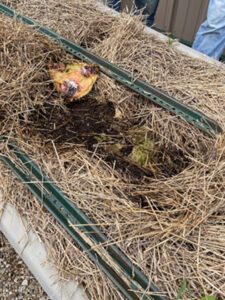
High Tunnel Garden and Outdoor Garden
Following the bioreactors, we got to see the high tunnel garden and outdoor garden. The high tunnel garden was a plastic covered tunnel. It allowed produce to grow in an area that they could not grow otherwise and for an extended season. Within the high tunnel garden, there were raised beds that hosted companion plantings. Companion planting is the arrangement of mutually beneficial plants next to each other within the same plot. Planting certain combinations of plants together can boost growth, repel pests, and improve the flavor of the food. Examples of companion planting I saw within the high tunnel were carrots/clove/tomatoes, chamomile/onion, and chives/Swiss chard. The outdoor garden was a pizza themed garden including tomatoes, peppers, basil, and cauliflower. All ingredients that can be used to make a cauliflower crust pizza!
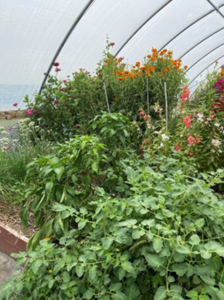

Beetle Bank
Moving on from the gardens, we next toured the beetle bank. A beetle bank is a raised linear berm planted with native grasses and forbs. The beetle bank’s purpose is to attract predatory beetles as a form of biological pest control for crops. Beetles are essential pollinators and beetle banks supply them with food and a home. There were so many bees, spiders, butterflies, moths, and beetles utilizing the beetle bank. I had never heard of a beetle bank before however, it was my favorite demonstration at the farm!
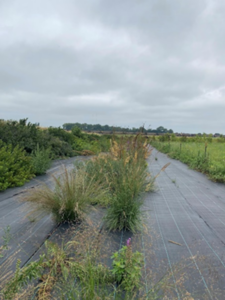
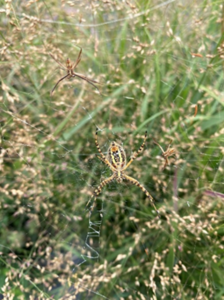
Multi-species Grazing and Cropping System
The last stop on our Menoken Farm tour was checking out the multi-species grazing system and crop fields! The two species that were rotationally grazing together were sheep and cattle. There were 30 sheep, 15 heifers, and 1 bull grazing on 9 grass species. According to one of the Menoken Farm staff,
the sheep think they’re cattle and the cattle think they’re sheep. The grazing system consists of short livestock exposure periods followed by long plant recovery periods. The Menoken Farm has 10 fields at 12 acres each. The cropping system of these fields includes no-till seeding, high crop diversity, and rotations with cover crop combinations seeded after harvest.
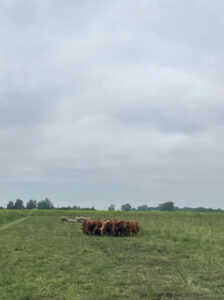
Well, there’s my recap of my first work training trip! During training at Menoken Farm, I got to delve into the foundational knowledge of soil health and see those soil health principles in action around the farm. The Menoken Farm staff were very knowledgeable and kindly answered all my questions. Overall, I had a great trip to North Dakota and look forward to more training opportunities soon!
